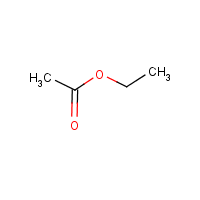Ethyl acetate
Agent Name
Ethyl acetate
CAS Number
141-78-6
Formula
C4-H8-O2
Major Category
Solvents

Synonyms
Acetate d'ethyle [French]; Acetato de etilo [Spanish]; Acetic acid, ethyl ester; Acetic ether; Acetidin; Acetoxyethane; Aethylacetat [German]; Essigester [German]; Ethyl acetate; Ethyl acetate (natural); Ethyl acetic ester; Ethyl ester; Ethyl ethanoate; Ethylacetaat [Dutch]; Ethylacetate; Ethyle (acetate d') [French]; Ethylester kyseliny octove [Czech]; Etile (acetato di) [Italian]; Octan etylu [Polish]; Vinegar naphtha; [ChemIDplus] UN1173
Category
Esters (<C12)
Description
A clear colorless liquid with a fruity odor; [CAMEO]
Sources/Uses
Used as a solvent for organic chemicals and surface coatings; [ACGIH]
Comments
Ethyl acetate is in the list of "Some volatile substances which may be abused by inhalation" published on the web site of the U.N. International Drug Control Programme, indicating its potential to cause narcosis in workers. [Reference #1] An eye and respiratory tract irritant; Inhalation of high concentrations may cause CNS effects; [ICSC]
Reference Link #1
Biomedical References
Exposure Assessment
Skin Designation (ACGIH)
Insufficient data
TLV (ACGIH)
400 ppm
PEL (OSHA)
400 ppm
MAK
200 ppm
IDLH (NIOSH)
2000 ppm
Excerpts from Documentation for IDLHs
Workers regularly exposed to concentrations from 375 to 1,500 ppm for several months showed no unusual signs or symptoms [Patty 1963]. Concentrations in the range of 8,000 to 20,000 ppm have been considered dangerous for short exposures [Henderson and Haggard 1943].
Vapor Pressure
93.2 mm Hg
Odor Threshold Low
6.4 ppm
Odor Threshold High
50 ppm
RD50
614 ppm
Lethal Concentration
LC50 (mice) = 45,000 mg/m3/2H
Explanatory Notes
IDLH = 10% LEL; Detection odor threshold from AIHA (mean = 18 ppm); Flash point = 7.2 deg C; VP from HSDB;
Half Life
No reports found; [TDR, p. 625]
NFPA
may ignite at ambient temp
Adverse Effects
Neurotoxin
Acute solvent syndrome
Diseases, Processes, and Activities Linked to This Agent
Diseases
Occupational diseases associated with exposure to this agent:
Processes
Industrial Processes with risk of exposure:
Activities
Activities with risk of exposure: